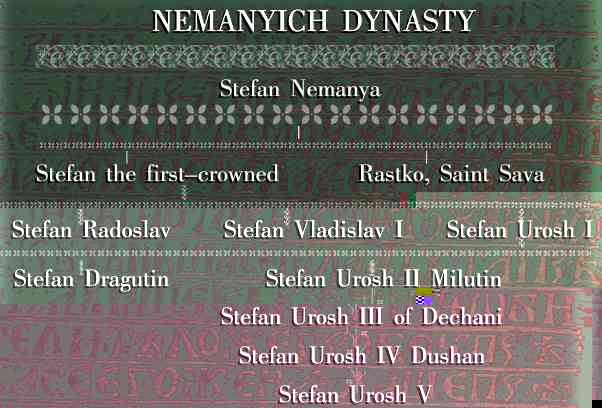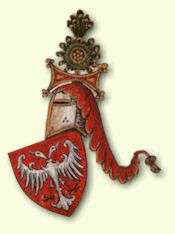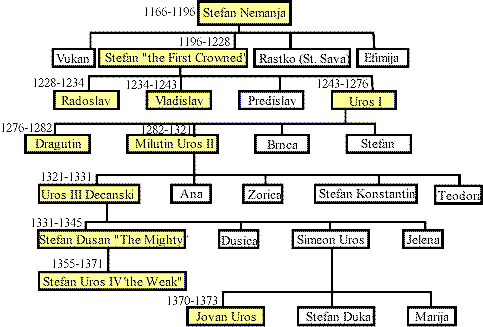










Monastery Chilandar
on Holy Mountain of Athos
in this, 1998 year the Chilandar Monastery celebrates its 800th Anniversary as
the Serbian Orthodox Monastery
| |

THE SACROSANCT NEMANYICH DYNASTY

It had ruled over the Serbian lands continuously, in the period from 1166 - 1371. Deeply
religious and devoted to Orthodoxy, all the rulers of this family were big donors who
erected many magnificent monasteries and churches all over Serbia: Studenica, Djurdjevi
Stupovi, Zhicha, Dechani, Grachanica, Milesheva, Sopochani,Chilandar, the sole Serbian
monastery on Mount Athos, flourished along with the family.
 Nemanjic Dinasty
Cote of Arms Nemanjic Dinasty
Cote of Arms
In the course of its two century reign, the Nemanyich dynasty
increased the monastery treasures. The members of the family erected new buildings and
repaired the old ones; they decorated and embellished it, making the name of the
Nemanyich dynasty linked forever to the history of Chilandar.
 
|
|
RASTKO NEMANYICH (+January 14, 1236)
Monk Sava, first Serbian Archbishop, Saint Sava
Rastko was the youngest son of the Grand Zhupan Stefan Nemanya. He was only
seventeen when some Russian monks arrived to his father’s court. As soon as he had
learned from them about Mount Athos, he left the court and went there in disguise. He had
entered a monastic order in the Russian monastery Old Roussikon, but invited by the
Vatopedi abbot, he moved into their community. He bestowed on them rich donations, erected
two churches and re-roofed the katholikon.
Five to six years after Sava had arrived to Mount Athos, his father, at the time
already Monk Symeon, joined him there. They met in the Vatopedi monastery and remained
there for a certain period of time. Soon both of them felt a desire to build a monastery
for their own Serbian people. After having gone through many troubles, they eventually
received the constitutional charter. By the Chrysobull of the Emperor Alexios III the
Angel, they were granted the ruined settlement of Chelandari to found there a Serbian
community. They started building it in 1198, and when Symeon died in 1199, Sava continued
with the works on his own. He went to Karyes, and founded there the Kellion of Saint Sava
of Jerusalem, where he subjected himself to a strenuous ascetic discipline for some time.
There he wrote the Karyes Typikon, thus laying the foundations of a strict monastic
tradition, which has been respected up to the present day. Beside writing the Chilandar
Typikon and Karyes Typikon, Monk Sava is also credited with translations of liturgical
literature. He wrote the father Symeon’s hagiography, the first literary work in
Serbian. It was in Chilandar that he conceived the idea of writing the Code of
Rules, as well as the Studenica Typikon.
According to his father’s wish, and at the request of his brothers Stefan and Vukan,
Sava had the relics of Nemanya transferred to Serbia in 1206. When Stefan received the
title of a king, in 1217, Sava returned to Mount Athos. He arranged the work of the
hospital in Chilandar, and then withdrew to the kellion in Karyes. Shortly after that, he
left for Nicaea, where in 1219 he received from the Byzantine Emperor and Patriarch
the autonomy for the Serbian church, and the title of Archbishop for himself.
The monastery Zhicha was chosen as the seat of the autocephalous Serbian Orthodox Church,
and it was there that Sava, some time later, preached his famous sermon on
Orthodoxy. He ruled the Serbian Church as an Archbishop for fourteen years, and during
that time he put it in order and strengthened its foundations. Sava travelled twice to the
East, to visit the Holy Land and the Holy Sepulchre. From his journeys he brought back
many relics, icons and other holy objects, many of which have been preserved in Chilandar
and in its kellia to the present day; icons of the Virgin Troyerutchitsa (of the Three
Hands) and the Virgin Galaktotrophousa (She Who Suckles), episcopal staff of St Sava of
Jerusalem called Pateritsa, a fragment of the True Cross, a splinter from the Crown of
Thorns and other.
Archbishop Sava died on January 14, 1236 in Trnovo, on his way back from the Holy Land.
The Serbian king Vladislav had his relics transferred to the monastery Milesheva, in 1237.
Out of fear from the saint, Sinan Pasha, a Serb converted into Islam, had the relics of St
Sava transferred from Milesheva to Belgrade, where he burned them on the Vrachar plateau
in 1594. On that very place, out of respect and gratitude, the Serbian people have
now been erecting the largest Orthodox temple in the world. The monks of Mount Athos and
Chilandar monastery traditionally make daily mention of Saint Sava’s miracles, of his
building of Chilandar, his writing of the Karyes Typikon with a cross-like stamp on it,
his kellion, hospital, tower in Chilandar. Many places that he used to visit still bear
his name: at the Sava’s Kellion, Sava’s Waters, St Sava’s Well...
The national tradition ascribes to St Sava many parables, miracles and tales, and the
Serbian people put him into the first place among their teachers and educators. His cult
is a very strong one. St Sava’s feast day is January 27th (14th by the old calendar),
and it is being celebrated both by the Serbian Church and all Serbs wherever they may
live. It is also celebrated as the school feast day.
|
STEFAN THE FIRST-CROWNED Grand
Zhupan (1196 - 1217) King (1217 - 1228)
St. Simon the Monk
Stefan was the second son of Stefan Nemanya. He succeeded his father to the Grand
Zhupan’s throne in 1196 and was crowned the first Serbian king in 1217. Through his
political activities he helped his brother, Chilandar monk Sava, to obtain in Nicaea, in
1219, the document of autonomy of the Serbian Church, as well as to be appointed the first
Serbian Archbishop.
The seat of the Archbishopric was in the monastery Zhicha, the endowment of Stefan the
First-crowned. In memory of his father, he wrote his hagiography and several charters to
various monasteries. Before his death, he had entered a monastic order and received the
name Simon. He was buried in Studenica, but due to frequent war dangers his relics had
been transferred for fourteen times, until they were finally returned to Studenica, where
they still rest in peace.
|
STEFAN RADOSLAV King (1228 - 1234)
Monk John
Radoslav was the oldest son of Stefan the First-crowned. He received the title of king
from the first Serbian Archbishop, the latter Saint Sava. Later, he entered a monastic
order himself, under the name of John. He had a large exonarthex added to the famous
foundations of his grandfather Nemanya, which is known as the Radoslav’s narthex in
the Holy Virgin Church of Studenica. He is also credited with the exonarthex of Zhicha,
the building of which had probably started before the death of Stefan the First-Crowned
(1228).
|
STEFAN VLADISLAV I King (1234 -
1243)
Vladislav was the second son of Stefan the First-crowned. In 1218 he had the monastery
Milesheva erected. About 1224 he ordered that all the distinguished members of the
Nemanyich dynasty should be painted in the monastery narthex. The procession started with
Stefan Nemanya, and finished with the figure of the donor, still a prince at the time,
holding a model of Milesheva in his hand. Sava, the First Serbian Archbishop, died in
Trnovo, Bulgaria, in 1236. Vladislav had his relics transferred to his endowment
Milesheva, where he buried them in the Church of Ascension, in 1237.
|
STEFAN DRAGUTIN King (1276 - 1282)
St. Monk Theoktist
Dragutin was the older son of Stefan Urosh I. After having abdicated the throne to his
younger brother Milutin, at the Dezhevo Assembly, in 1282. Until his death in 1316, he
ruled over a mighty kingdom in the regions of Podrinje, Posavina and Shumadia-Branichevo,
independent of his brother Milutin. He erected various churches, the most famous being the
Church of St. Achillius in Arilje, the seat of the Morava Bishopric, in 1296. He entered a
monastic order at the end of his life, receiving the name of Theoktist. He led a deeply
religious, almost ascetic life, making many good deeds. In his home he manufactured
liturgical vessels which he gave away as presents to many churches and monasteries in
Russia, Jerusalem, on Mount Sinai and other holy places. He took care of religious purity
and had many Bosnian heretics converted into Christianity. Only upon his death it was
revealed how blessed he really was. Namely, when the courtiers wanted to bathe him, they
found out that under his sumptuous garments he had all his life worn coarse linen
clothing, the straw-belt of which was deeply cut into his body. His relics were first
buried in the monastery Djurdjevi Stupovi. They were transferred to Studenica at a later
date, and they still rest there next to the tomb of St. Symeon.
|
 |
|
|
|
STEFAN UROSH II MILUTIN King
(1282 - 1321)
St. King Milutin
Milutin was the younger son of Stefan Urosh I. He was, after St. Symeon and St. Sava,
the biggest donor of Chilandar and the biggest donor in general among all members of the
sacrosanct Nemanyich dynasty. His hagiography writers claimed that he had erected more
than forty churches and monasteries. He built in Jerusalem, Constantinople, Salonika, in
Macedonia, Serbia and on Mount Athos. He also built in Bari and Rome, but most of all in
Chilandar. He gave the final touch to the Chilandar monastery precincts, giving it
splendor, so all the other donors only added to or repaired damaged buildings. Without
Milutin there would be no Chilandar katholikon, which is maybe the most magnificent
building of Mount Athos. There would also be no Chilandar refectory, built on the place of
the old refectory of St.Symeon and St. Sava. He also completed the Cemetery Church, which
was first dedicated to the Holy Apostles Peter and Paul, and later to Annunciation.
He also took care of defense objects of Chilandar, and had the upper third of the St.
Sava’s Tower built. Between 1300 and 1302, he answered the request of the Chilandar
abbot Kyriakos, and erected the large Hrussia Tower. Immediately after that, he had a
magnificent tower built on the Sava’s Field, which was named after him Milutin’s
Tower. With his monies he also erected the tower of hieromonach Theodoulos in Karyes, next
to the Kellion of St. Sava, but it has not been preserved to the present day.
King Milutin filled up all these buildings with frescoes, icons, ecclesiastical
vessels, books and embroideries. A lot of them were lost with the time, but many of them
have also been preserved in churches and in monasteries’ treasuries. The exceptional
diptych with miniatures of Venetian art, was donated to Chilandar monastery by the
"Christ loving and God fearing King".
|
STEFAN UROSH III OF DECHANI King (1321 - 1331)
St. Stefan of Dechani
Stefan Urosh III was the son of King Milutin. Out of his love for Christ, as well as
gratitude to the Chilandar community which had mediated in his reconciliation with his
father Milutin, Stefan built in the courtyard of the Hrussia Tower, in Chilandar, the
Church of St. Basil. He built many more endowments, the most famous being the monastery of
Christ the Pantocrator near Dechani, in Metochia, after which the King was named by the
people "Stefan of Dechani". Because of its architectural symmetry, lavish
sculptural ornamentation, theological themes of paintings and richness of the monastery
treasury, Dechani represents one of the most significant monuments of the Serbian medieval
heritage.
Relics of the donor, Stefan of Dechani, are resting in peace in the Dechani monastery.
|
|

|
|
 
|
